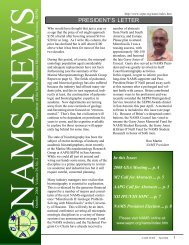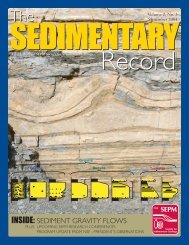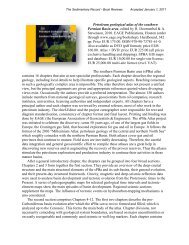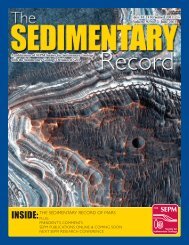PDF of contents and abstracts - SEPM
PDF of contents and abstracts - SEPM
PDF of contents and abstracts - SEPM
Create successful ePaper yourself
Turn your PDF publications into a flip-book with our unique Google optimized e-Paper software.
ALLUVIAL STACKING PATTERN ANALYSIS AND SEQUENCE<br />
STRATIGRAPHY: CONCEPTS AND CASE STUDIES<br />
STACY C. ATCHLEY, LEE C. NORDT, AND STEPHEN I. DWORKIN<br />
Baylor University, Department <strong>of</strong> Geology, One Bear Place #97354, Waco,<br />
Texas 76798-7354, USA<br />
e-mail: stacy_atchley@baylor.edu<br />
DAVID M. CLEVELAND<br />
ExxonMobil Upstream Research Company, 3120 Buffalo Speedway, Room SW640, Houston,<br />
Texas 77098, USA<br />
JASON S. MINTZ<br />
Anadarko Petroleum Corporation, 1201 Lake Robbins Drive, The Woodl<strong>and</strong>s,<br />
Texas 77380, USA<br />
AND<br />
R. HUNTER HARLOW<br />
Kansas Geological Survey, 1930 Constant Avenue, Lawrence, Kansas 66047, USA<br />
ABSTRACT: Modern sequence-stratigraphic theory has its foundation in the work <strong>of</strong> L.L. Sloss <strong>and</strong><br />
W.C. Krumbein (1940s–1960s) <strong>and</strong> several Exxon researchers (1970s–1990s). This work largely focuses<br />
on the nature <strong>and</strong> origin <strong>of</strong> sedimentary cycles within marine stratal successions. More recently,<br />
sequence-stratigraphic concepts have evolved to include the analysis <strong>of</strong> terrestrial strata. Historically, the<br />
recognition <strong>of</strong> unconformity-bounded cyclic stratal units (such as sequences) has relied upon the<br />
geometric relationships <strong>of</strong> strata (i.e., onlap, toplap, truncation, <strong>and</strong> downlap) within two- <strong>and</strong>/or threedimensional<br />
outcrop or subsurface successions. Oftentimes, however, outcrops or boreholes are isolated<br />
<strong>and</strong> do not preserve these diagnostic stratal relationships. In such instances, documentation <strong>of</strong> changes in<br />
the vertical, rather than lateral, succession <strong>of</strong> strata may allow reconstruction <strong>of</strong> the cyclic accommodation<br />
history <strong>and</strong> placement <strong>of</strong> associated bounding discontinuities. This technique, referred to as “stacking<br />
pattern” analysis, was originally developed for shallow-marine carbonate successions. More recently, the<br />
stacking pattern methodology has been similarly applied to alluvial successions <strong>and</strong> takes into account the<br />
unique processes <strong>of</strong> terrestrial deposition <strong>and</strong> pedogenesis. The most conspicuous <strong>and</strong> fundamental cyclic<br />
stratal units recognized within alluvial settings are fluvial aggradational cycles (FACs). Fluvial<br />
aggradational cycles are meter-scale, typically fining-upward successions that have a disconformable<br />
lower boundary <strong>and</strong> an upper boundary that either has a paleosol weathered into it or is disconformably<br />
overlain by the succeeding FAC without a paleosol. Fluvial aggradational cycles are thought to represent<br />
sediment accumulations during channel avulsion events that are subsequently weathered during the<br />
following period <strong>of</strong> channel stability. A thick succession <strong>of</strong> FACs indicates sediment accumulation during<br />
a prolonged episode <strong>of</strong> accommodation gain. Variations in the rate <strong>of</strong> accommodation gain (<strong>and</strong> loss) are<br />
interpreted to result in the organization <strong>of</strong> FACs into alluvial sequences <strong>and</strong> longer period composite<br />
sequences. Episodes <strong>of</strong> base-level rise result in relatively rapid rates <strong>of</strong> alluvial aggradation <strong>and</strong> less<br />
developed <strong>and</strong> more poorly drained paleosols. Associated FACs are thicker than average <strong>and</strong> transition<br />
from initially lower sinuosity, higher competence alluvial systems to comparably higher sinuosity, lower<br />
competence channel deposits. As base-level rise decelerates <strong>and</strong> initially falls, paleosols become<br />
increasingly well developed <strong>and</strong> better drained, <strong>and</strong> FACs are thinner than average <strong>and</strong> transition to even<br />
lower competence, higher sinuosity channel s<strong>and</strong>stones that are more extensive as a result <strong>of</strong> prolonged<br />
channel migration under low accommodation conditions. During base-level fall, the incisement <strong>of</strong> alluvial






